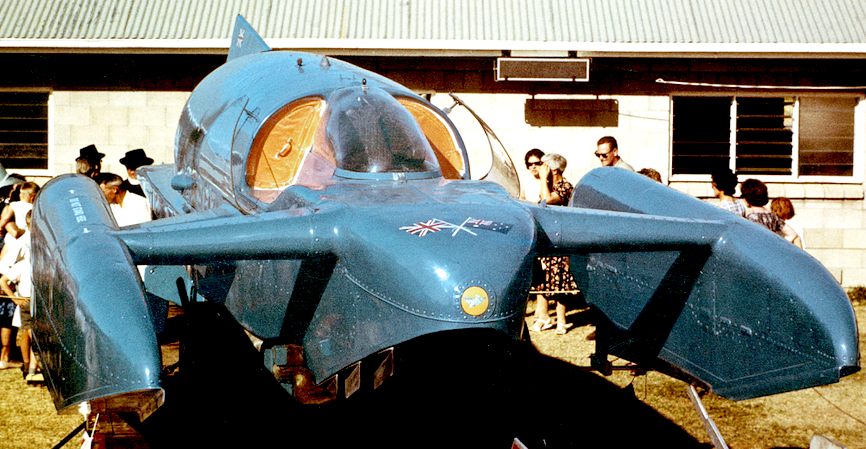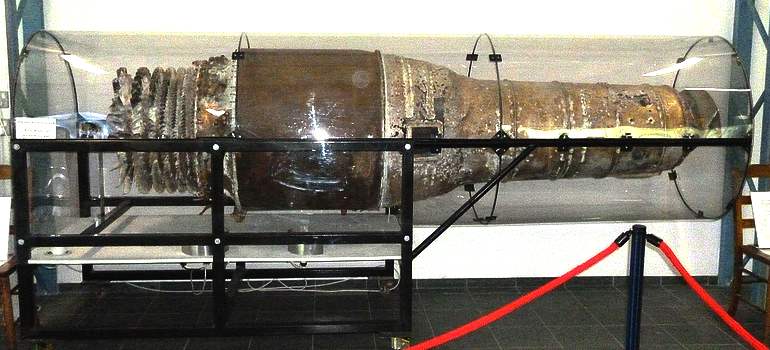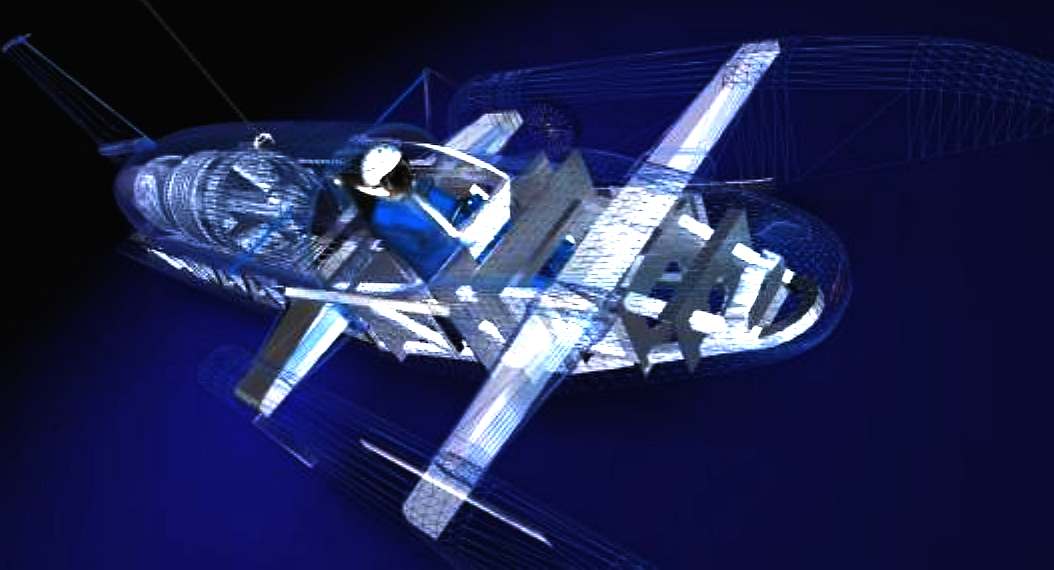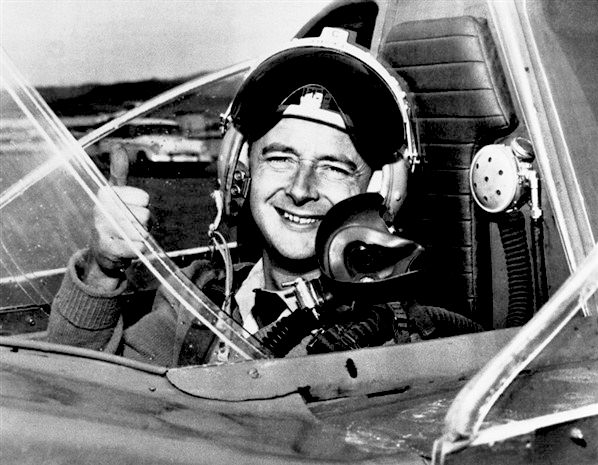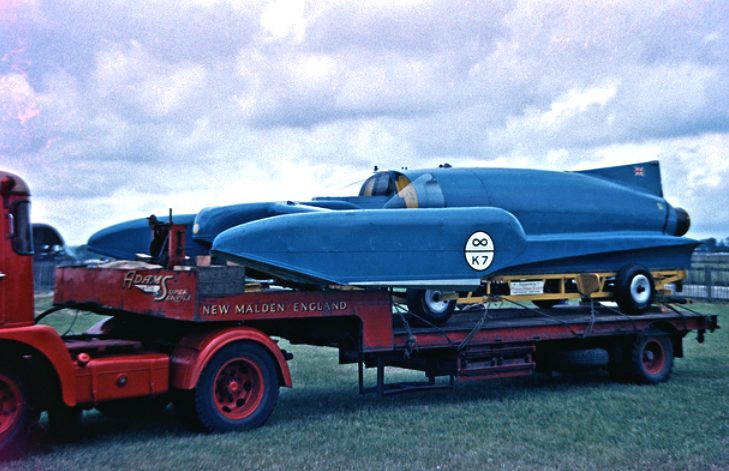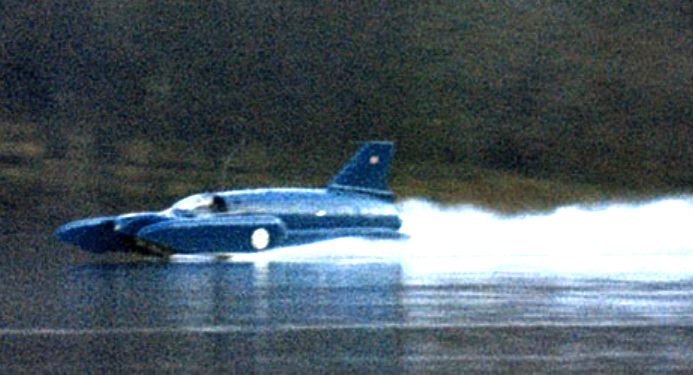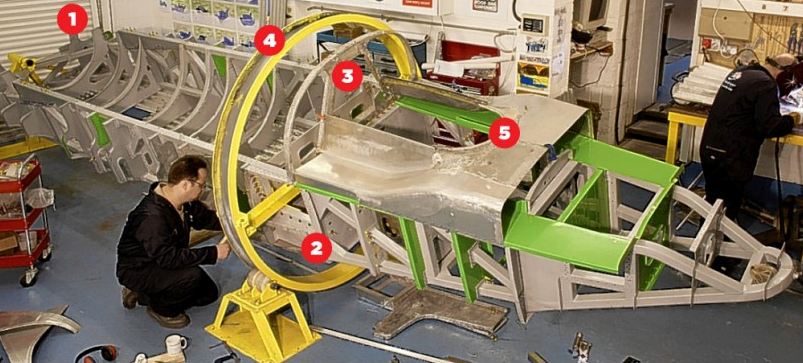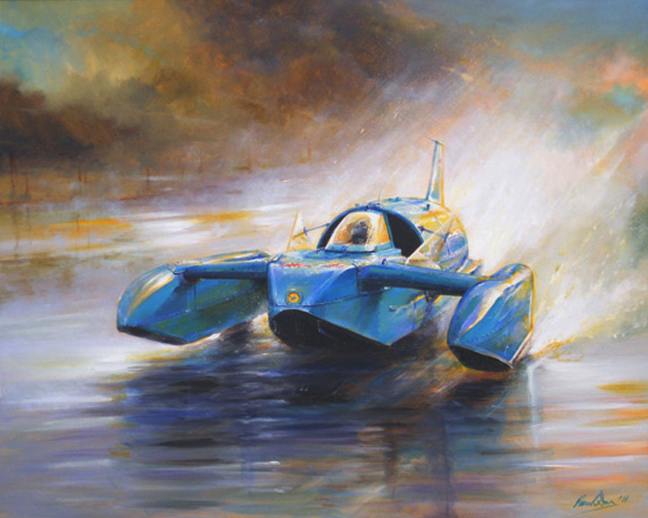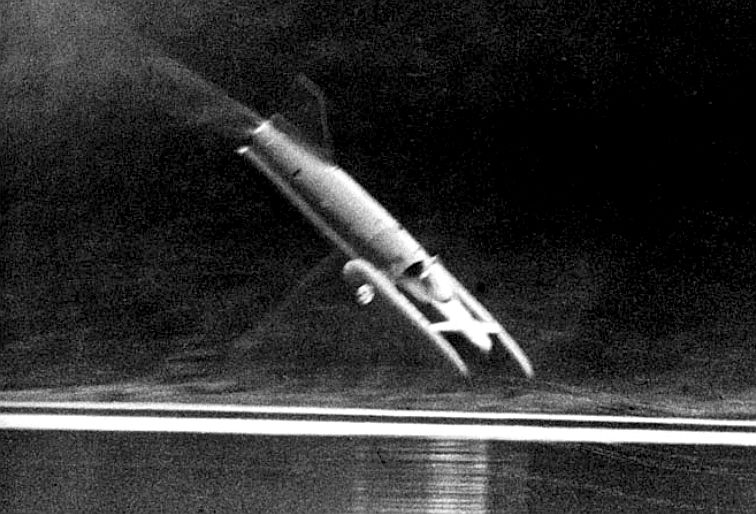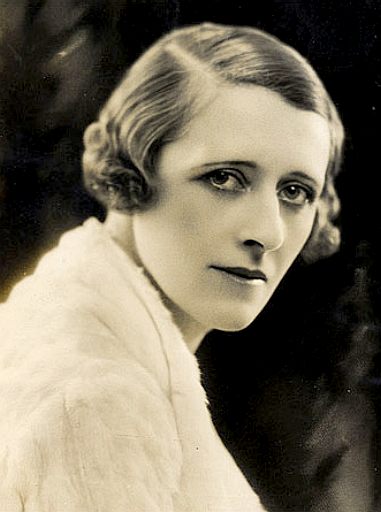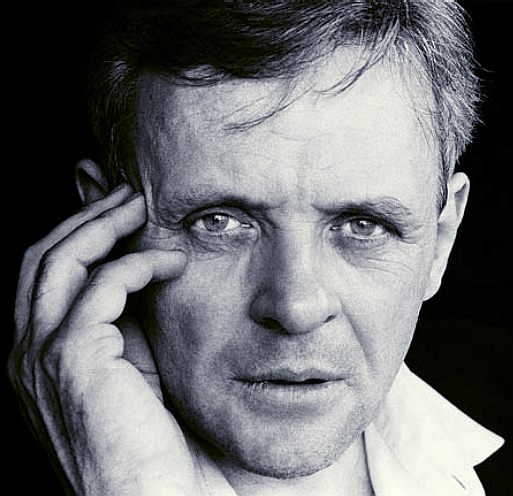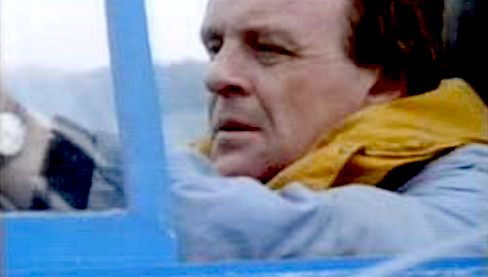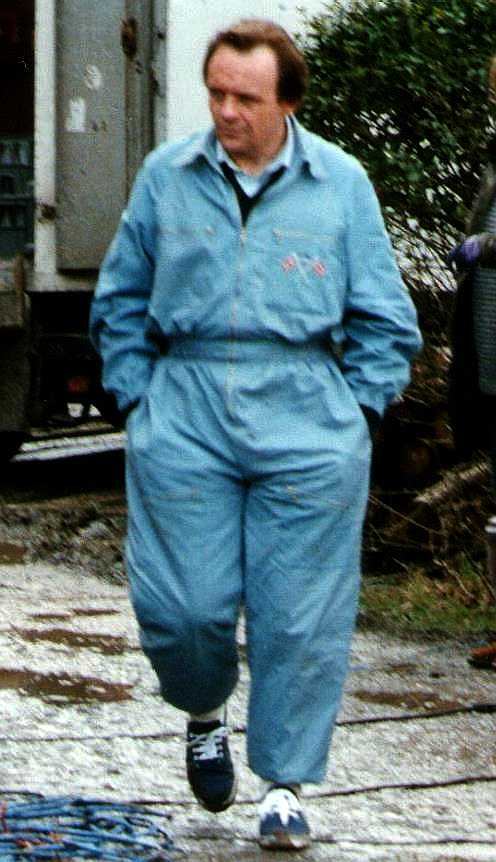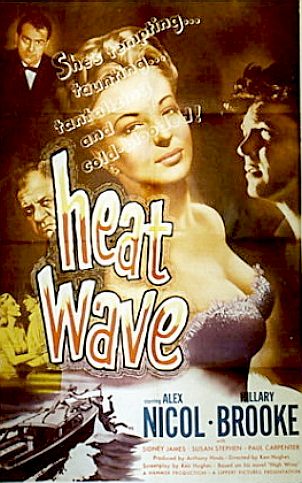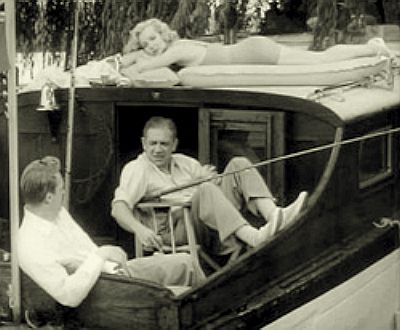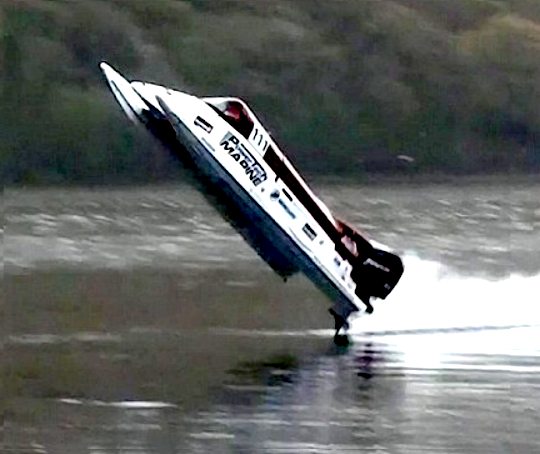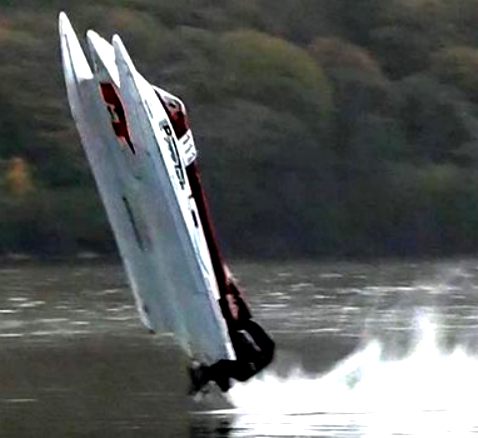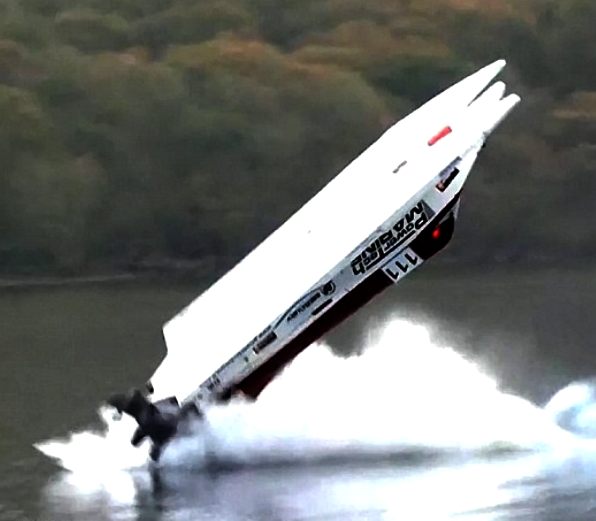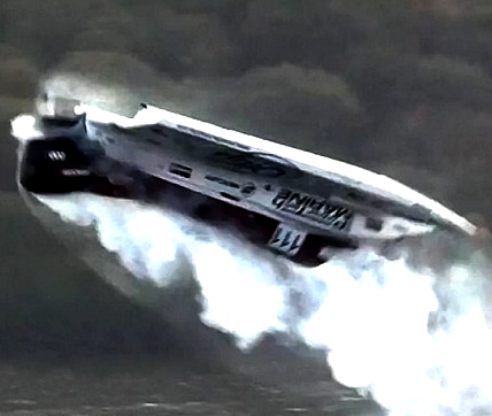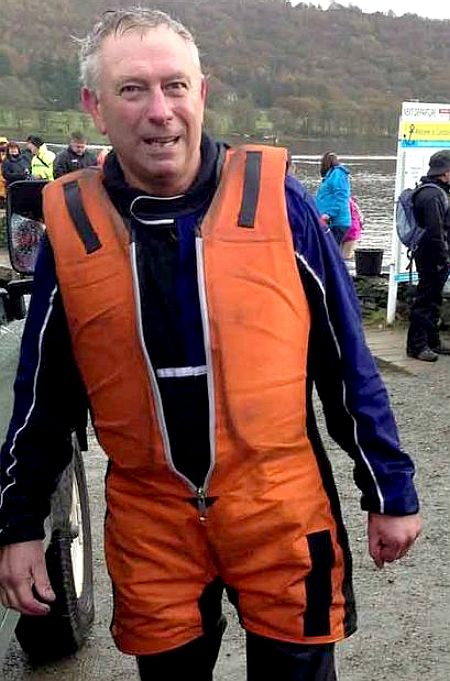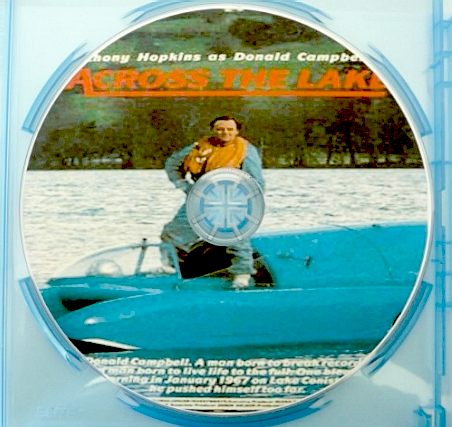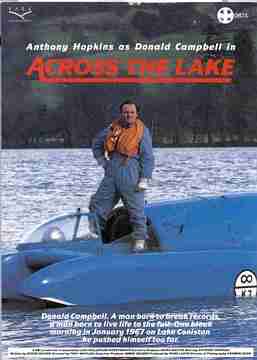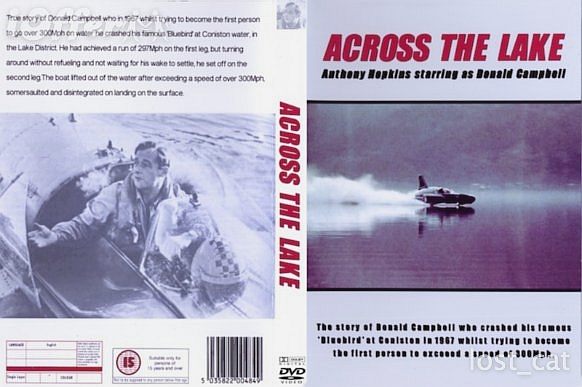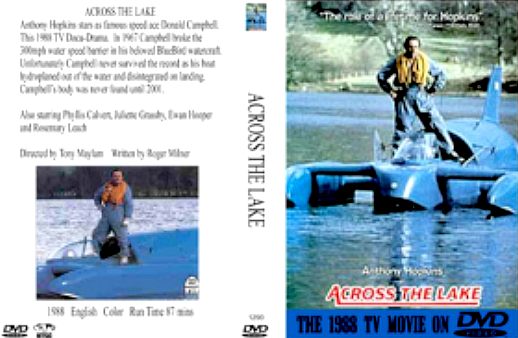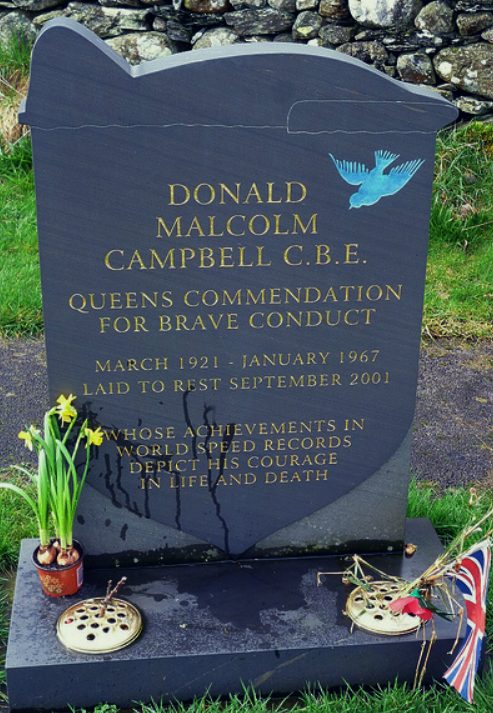|
ACROSS THE LAKE
|
|
In his time Donald Campbell crossed many lakes in two continents in his superb K7 vessel, or as the press sometimes called it: the blue lobster. There might have been a third if the US had a lake on offer. Donald loved the adventure of travel. The Bluebird K7 was a turbo jet-engined three-point hydroplane with which the UK's speed ace set seven outright world water speed records during the 1950s and 1960s. Donald lost his life in K7 on January the 4th 1967 whilst making a bid to raise the speed record to over 300 miles per hour (480 km/h) on Coniston Water - a noble cause. K7 was designed largely by Ken and Lewis Norris with the assistance of Donald Stevens and practical input from Leo Villa.
A stunning photograph of the K7 at the Barmera Monash Football Club, Australia, in 1964
Design
Following rival racer John Cobb's death in Crusader in 1952, Campbell began development of his own all metal jet-powered Bluebird K7 to challenge the record held by the American hydroplane Slo-Mo-Shun IV. Designed by Ken and Lew Norris, the K7 was an aluminium, three-point hydroplane with a Metropolitan-Vickers Beryl axial-flow turbojet engine, producing 3500 pound-force (16 kN) of thrust.
Like Slo-Mo-Shun, but unlike Cobb's tricycle Crusader, the three points were arranged in "pickle-fork" layout, prompting Bluebird's early comparison to a blue lobster. It was very advanced, and remained the only successful jet-boat until well into the 1960s.
The name "K7" was derived from its Lloyd's unlimited rating registration. It was carried on a prominent circular badge on its sponsons, underneath an infinity symbol.
Encased in plastic, the jet engine stands as a shrine to the fateful day in January 1967, when Donald Campbell crossed the lake too fast. Jet engines were developed before WW2 by Frank Whittle, then not progressed by the Ministry of Defence who were not so forward thinking as they might have been, which, if they had been on the ball, could have shortened that war.
Campbell set seven world water speed records in K7 between 1955 and 1964. The first of these occurred at Ullswater on 23 July 1955, where he set a record of 202.15 mph (324 km/h). Campbell achieved a steady series of subsequent speed-record increases with the boat during the rest of the decade, beginning with a mark of 216 mph (348 km/h) in 1955 on Lake Mead. Subsequently, four new marks were registered on Coniston Water, where Campbell and Bluebird became an annual fixture in the later half of the fifties, enjoying significant sponsorship from the Mobil oil company and then subsequently BP. There was also an unsuccessful attempt in 1957 at Canandaigua in New York state in the summer of 1957, which failed due to lack of suitable water conditions. Bluebird K7 became a popular attraction, and well as her annual Coniston appearances, K7 was displayed extensively in the UK, USA, Canada and Europe, and then subsequently in Australia during Campbell's prolonged attempt on the land speed record (LSR) in 1963 - 64.
RESTORATION: New parts of the steel frame are green. 1. The first of 23 frames 2. Frame 15 where the boat snapped 3. Air intake frame 4. Yellow roll jig to spin the craft for welding 5. Cockpit area.
The second run was even faster; as K7 passed the start of the measured kilometer, she was traveling at over 320 mph (510 km/h). However her stability had begun to break down as she traveled at speed she had never achieved before, and the front of the boat started to bounce out of the water on the starboard side. 150 yards from the end of the measured mile, K7 lifted from the surface and after about 1.5 seconds, gradually lifted from the water at an ever increasing angle, before she took off at a 90-degree to the water surface. She somersaulted and plunged back into the lake, nose first, unlike John Cobb's Crusader, where the forward hull disintegrated.
The boat then cartwheeled across the water before coming to rest. The impact broke K7 forward of the air intakes (where Donald was sitting) and the main hull sank shortly afterwards. Campbell had been killed instantly. Mr Whoppit, Campbell's teddy bear mascot, was found among the floating debris and the pilot's helmet was recovered. Royal Navy divers made efforts to find and recover the body but, although the wreck of K7 was found, they called off the search after two weeks, without locating his body.
Mr Whoppit, Campbell's luck mascot
The cause of the crash has been variously attributed to Campbell not waiting to refuel after doing a first run of 297.6 mph (478.9 km/h) and hence the boat being lighter; the wash caused by his first run and made much worse by the use of the water brake, (These factors have since been found to be not particularly important. The water brake was used well to the south of the measured distance, and only from approx. 200 mph (320 km/h) The area in the centre of the course, where Bluebird was traveling at peak speed on her return run was flat calm, and not disturbed by the wash from the first run, which had not had time to be reflected back on the course.
Across the Lake painting by Paul Dove (acrylic on canvas) - bold Turneresque use of colour
The fuel tank was in approximately the same position as K7's centre of gravity, and therefore had little impact on the boats weight distribution), and potentially a cut-out of the jet engine caused by fuel starvation. (The configuration of K7 at high speed meant that the thrust of the jet engine provided a downward pressure at the bows of the boat. K7 was operating at her absolute limit in terms of a nose up pitching angle of 6'. A sudden loss of power caused by an interruption to fuel flow would mean that this down-thrust was lost and K7's bows would have risen above the 6' safe limit). Some evidence for this last possibility may be seen in film recordings of the crash below - as the nose of the boat climbs and the jet exhaust points at the water surface no disturbance or spray can be seen at all. Jet powered models of the K7 appear to perform rather better for some reason.
Milliseconds before death, Donald Campbell plunges into a watery grave where he will remain undisturbed for the next 34 years.
A bitter dispute as to ownership and rights to operate, has broken out and is still unresolved at time of writing (25-01-2023). We are sure all fans of Bluebird land and water speed record vehicles, will be pleased to see the K7, above, running again on water. As many readers will know, Bill Smith has spent 15 years of his life restoring the jet powered Bluebird, the passion of Donald Campbell, until he pushed the design too far in 1967. Despite agreement as to operational rights, the Ruskin Museum in Cumbria is now seeking to default on that agreement, without offering Mr Smith compensation for his fifteen years of project management and time spent actually working on the fated hydroplane. This might seem like a one off dispute, until you look back in time at the various disputes between Sir Malcolm Campbell and Rolls-Royce, Donald Campbell and Ken Norris, and Don Wales and the designer/builder of the Bluebird Electric racing cars. Taken in that context, the present dispute is just another in a chain, that seems to have passed down the family as an embedded DNA profile. Of course that is just speculation, whereas the history of disputes is indisputable. When it comes to paying, just like the addiction to speed, it seems to run in the family, allegedly.
SALVAGE & RESTORATION
An experienced salvage diver named Bill Smith, recovered the K7 in 2001 and for the next 13 years has worked on restoring the craft to its former glory, by way of a tribute to one of the greatest speed kings that ever lived. It is hoped that a great deal of scientific data might have been gleaned from the re-build.
In July of 2014, Tonia Bern-Campbell visited the National Motor Museum to give a talk about Donald and herself on the occasion of the 50th anniversary of Donald's fateful final trip across the lake.
Lady Dorothy Campbell, Donald's mother. She survived Sir Malcolm's stroke, and despite their best efforts to ensure that their son Donald did not take up such a risky sport, Donald found a way. There was also the potential that Donald may have been unsuccessful in his attempts, so detracting from Sir Malcolm's excellent record, but in fact Donald did an amazing PR job, taking the legend to new heights. Whereas, subsequent more recent efforts to go fast have been unimpressive low speed fillers, not really progressing the art - as Lady Campbell, Sir Malcolm and Donald would, we feel, undoubtedly have wanted, despite the inevitable father and son rivalry.
FILM REVIEW
Across the Lake details the final two months in the life of British "speed king" Donald Campbell, here played by the ubiquitous Anthony Hopkins. Haunted by the spectre of his equally famous father, who years earlier had set the world land speed record, Campbell is determined to carve his own niche by challenged the water speed record in his own personal motored vessel, the Bluebird. Alas, this undertaking proves to be the headstrong Campbell's undoing. Verteran stage and screen actress Phyllis Calvert makes a rare TV appearance as Donald's mother, Lady Campbell (seen above). Across the Lake was telecast by BBC1 as a Docu-Drama in 1988.
You could not have cast a better actor to play Donald Campbell. Anthony Hopkins is superb and we think has a genuine interest in land and water speed records and the contenders. He also plays Burt Munro in The World's Fastest Indian.
FILM WITH A SIMILAR NAME, UK: THE HOUSE ACROSS THE LAKE - USA: HEAT WAVE
Plot
- An American pulp novelist, Mark Kendrick (Alex Nicol), meets his rich neighbors across the lake and is soon seduced by beautiful blonde Carol (Hillary Brooke), the wife of the older Forrest (Sid James). Forrest is badly injured when his boat has an accident in
the
fog, and Carol throws him overboard.
House Across the Lake - Movie poster, a similar name to the BBC TV film, but a completely different plot that is pure fiction. Across the Lake, the BBC title is based on factual events in the life of Donald Campbell also leading to a death, but a spectacular finale brought about by one man trying to make a difference.
When Kendrick finds out about the betrayal he angrily confronts her and she sneers at him that she only used him and that there's nothing he could do about it. Mark confesses, knowing that doing so would only mean a prison sentence for him.
PRODUCTION TEAM
45 YEARS ON - HISTORY REPEATS ITSELF
A
record breaking power-boater survived a high speed crash at the same beauty spot where Donald Campbell was killed 45 years earlier.
Keith Whittle's 130mph wipeout brought back vivid memories of the terrifying final moments of the doomed
Bluebird K7 on the same stretch of Coniston Water in the Lake District.
Haven't we been here before? The lucky driver, Keith Whittle, swam away from this one. Gina Campbell had a near identical experience in a similar design of boat.
Keith had just set a new record for the Formula 2 class of racing boats before his 200hp craft Pepstar spectacularly looped the loop in front of hundreds of shocked spectators. Keith had reached 132mph - smashing the previous best in his of 124mph. Fearing the worst, to the utter amazement of the crowds gathered for Coniston Powerboat Records Week, Keith swam away from the inverted craft without so much as a scratch.
An eyewitness, Martin Campbell is quoted as saying:
"Your initial response is hoping the driver gets out and he did but it is still quite shocking when it happens.
Keith Whittle - shaken but not deterred
"Keith was trying hard for the record and when you're right on the edge these things can happen."
Anthony Hopkins plays Donald Campbell in the fact based BBC TV tribute docudrama that was never released, but should have been available in wide screen and hi definition, if they were to do the speed king justice. The arrogance of this institutionalized organization is nothing less than astonishing. Especially when one considers that they are playing with public money.
SIR MALCOLM CAMPBELL'S BLUE BIRDS
DONALD CAMPBELL'S BLUEBIRDS
Jetstar (not a bluebird, but a runabout that Donald loved)
The gravestone of Donald Campbell CBE. Note the blue bird legend (top right slate headstone) that inspired a nation of engineers, and that we have adopted to carry on the great mans futurist tradition in developing advanced technology for vehicles on land and water.
LINKS
I Luv That Movie Wordpress Across the Lake DVD 1988 Anthony Hopkins Rotten Tomatoes Across The Lake Brit Movie Films The-House-Across-the-Lake_1953 Wikipedia The_House_Across_the_Lake I Offer Across The Lake 1988 Donald Campbell DVD http://www.britmovie.co.uk/films/The-House-Across-the-Lake_1953/listType/year http://www.ioffer.com/i/across-the-lake-1988-donald-campbell-dvd-188864828 http://www.rottentomatoes.com/m/across-the-lake/ http://en.wikipedia.org/wiki/The_House_Across_the_Lake http://en.wikipedia.org/wiki/Mr_Whoppit http://www.k7projectbluebird.net/
|
|
This
website is Copyright © 2023 Bluebird Marine
Systems Ltd. The
names Bluebird,
Blueplanet BE3™, Utopia
Tristar™ and the blue bird in flight
|
